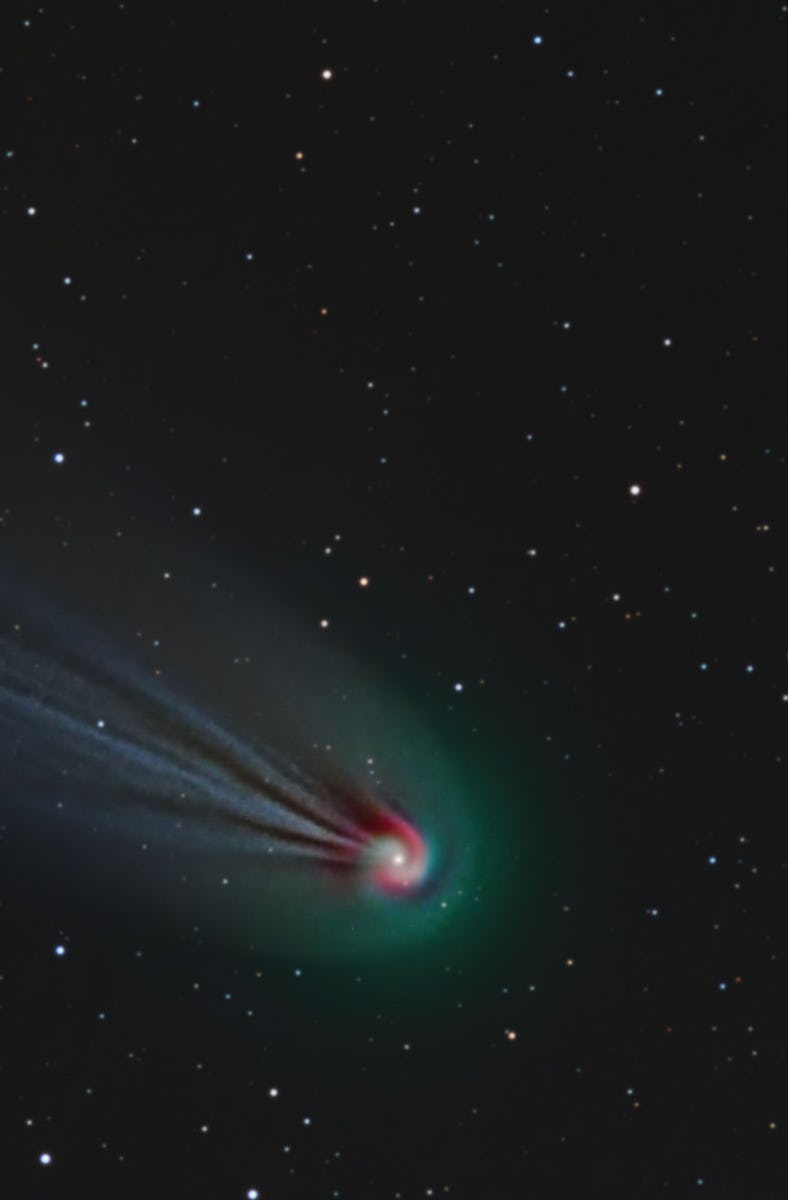The Solar Eclipse May Include A Rare Comet If You Look In Just the Right Spot
The comet might be bright enough to see with the unaided eye during the eclipse, but only if it erupts at the right time.

As darkness descends over the path of totality on April 8 — when a solar eclipse will make its way across the United States — you won’t want to miss a surprise event just to the left of the blackout: A baleful green light, crowned by a pair of wispy horns. Rest assured, it’s not an ill omen, just a very cool comet.
An icy volcanic comet is currently making its routine pass through the inner Solar System. It’s nearly bright enough to see with the unaided eye in the evening sky, and a well-timed eruption may make it show up in the brief daytime darkness of the solar eclipse.
It’s hard to predict exactly when the comet will erupt again.
This comet is made of ice, but has no chill
Comet 12P/Pons-Brooks swoops past Earth once every 71 years on its way around the Sun, and this year’s visit happens to overlap with the solar eclipse that will be visible across a long, narrow swath of North America on April 8. And it has a definite flair for the dramatic.
If magma were made of slushy ice instead of viscous molten rock, that would be the filling inside 12P/Pons-Brooks’ icy shell. As the comet gets closer to the Sun, it gets warmer — and pressure builds up inside. The warmer cryo magma forces its way up through cracks or weak spots in the comet’s icy exterior until it erupts at the surface. Just like normal hot magma, the comet’s cryomagma has gas mixed in with the slush. Gas escapes from the slushy ice mixture during the eruption (again, just like the fiery volcanoes we’re used to on Earth) and surrounds the comet in a glittering halo.
After an eruption, the comet shines dramatically brighter as its new halo of cryovolcanic gas reflects the Sun’s light. Astronomers call this an “outburst,” and 12P/Pons-Brooks is known for them. The comet has erupted and brightened several times in the last few months: twice in November, once in December, and once in January.
Comet 12P/Pons-Brooks’ halo of cryovolcanic gas glows green and red, with a long blue tail, because the gas reflects only certain wavelengths of the Sun’s light. And because its halo is shaped by the eruptions that spawned it, it has a horseshoe shape that looks a bit like a pair of horns.
The comet is already nearly bright enough to see with the unaided eye in the evening sky. In fact, you can already get a good view with binoculars. It’s going to get steadily brighter between now and April 21, when it passes closest to the Sun. To see 12P/Pons-Brooks, look low in the northwestern sky shortly after sunset.
However, whether the comet shows up during the solar eclipse depends on whether it erupts at the right time (probably a day or two before the big event). The sudden midday darkness as the Moon passes in front of the Sun is an amazing thing to behold, but it’s more like twilight than full darkness. That means comet 12P/Pons-Brooks will have to deliver a pretty dramatic outburst to be visible during the eclipse.
Astronomers have no way to predict whether, or when, that will happen — but there’s always a chance! If you want to look for the comet during the eclipse, look slightly above and to the left of the Sun. Hold your arms straight out with your two clenched fists together, and the width of your fists should measure (roughly) the distance between the Sun and the comet.
Even if the comet doesn’t make an appearance during the eclipse itself, its appearance in the evening sky just after sunset will make the perfect finale to a day of skywatching.